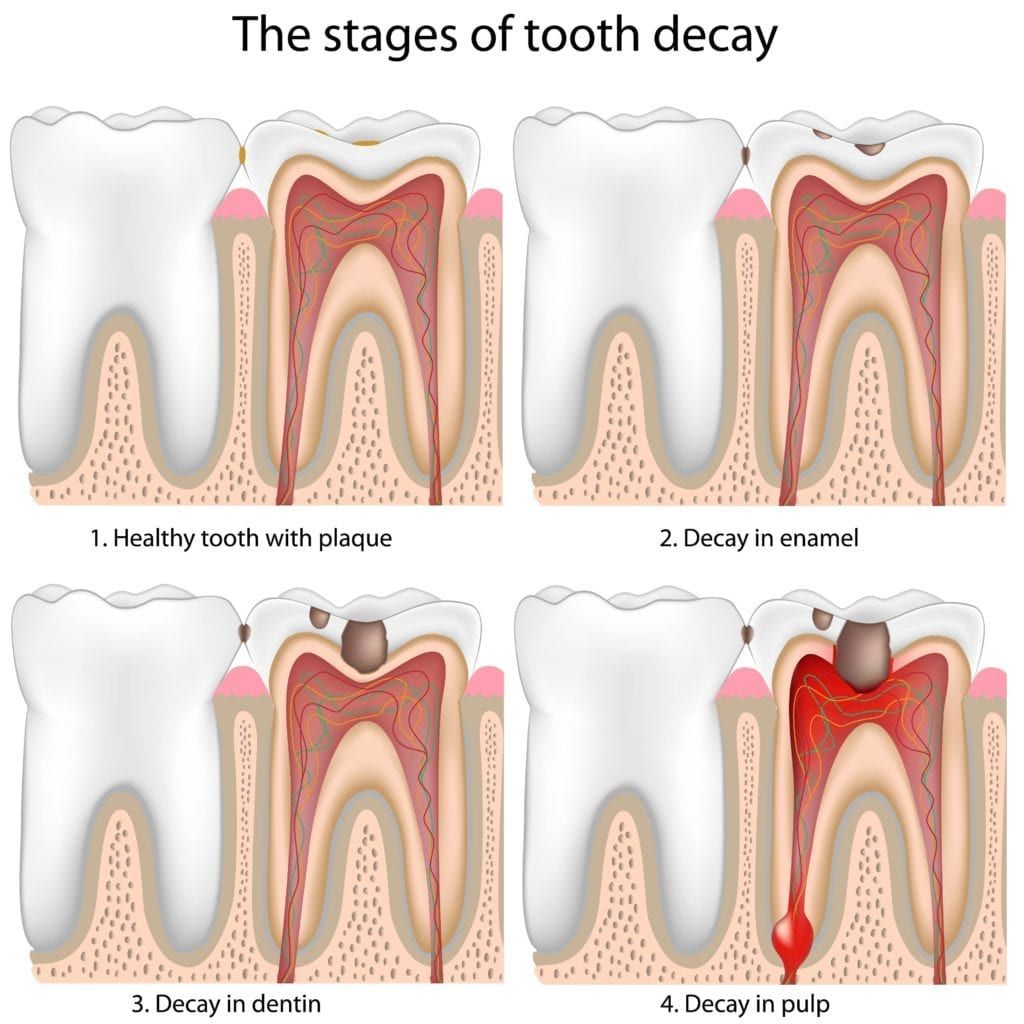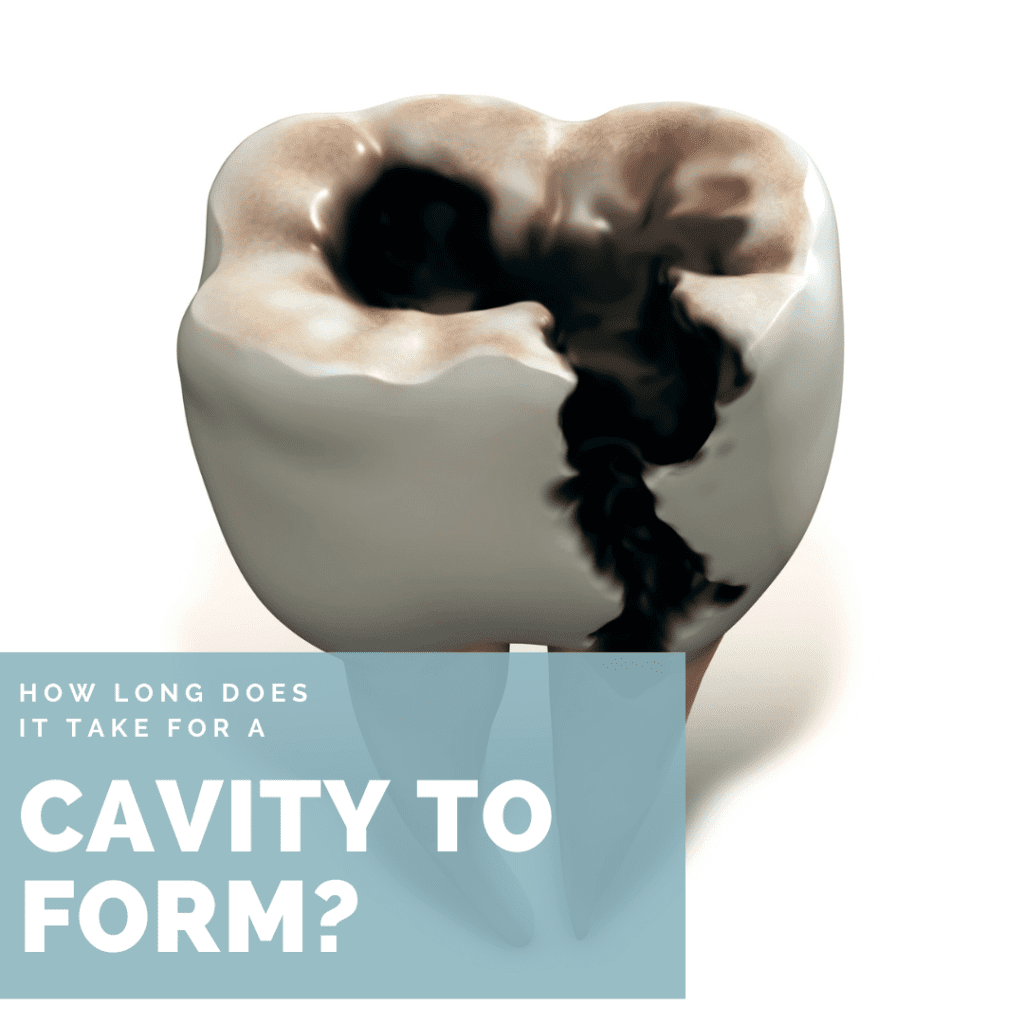According to the National Institute of Dental and Craniofacial Research, as many as 92% of adults aged 20-64 have had at least one cavity, with an average of 3 decayed teeth. While the average number of missing teeth in adults from the ages of 20-34 falls at 0.62, by the ages of 50-64, the average number of missing teeth due to decay rises to 5. This raises the question of how long it takes a cavity to form and at what point does tooth decay result in the loss of the tooth. Despite the fact that there is no exact answer to how long it takes a cavity to form, looking more closely at what cavities are and how they form can help to provide some semblance of an answer.

Cavities are holes in the teeth where the enamel has been eroded from acids produced by bacteria. These bacteria are naturally-occurring and reside in the sticky, clear film known as dental plaque. When food particles made up of sugar and starch become trapped in plaque, bacteria are able to feed on these food particles and convert them into acidic waste. This acidic waste is deposited onto the tooth surface, where it damages the enamel. As more and more waste is produced by bacteria, the enamel will eventually begin to erode from the high concentration of acid.
Cavities can form on the smooth surfaces of the teeth, on the roots, and within the pits and fissures of chewing surfaces. Smooth-surface cavities are not very common, while pit and fissure cavities are one of the most common types. This is because the molars and premolars have a highly textured surface that traps plaque and is hard to clean. Root cavities are also somewhat common, although they are generally seen in cases where the gums have receded. Without the gums to protect the tooth roots, they are more susceptible to decay since they only have a thin layer of protective enamel unlike the rest of the tooth.
Now that we know what a cavity is, what causes them, and where they form, let’s take a look at how they form. After all, cavities don’t just appear. In fact, there is a five stage process for cavity formation:
Stage 1: Demineralization
Enamel is primarily composed of minerals, however as the acids from bacteria are deposited onto the surface of the teeth, they cause the enamel to lose minerals. The more minerals that are lost, the weaker the enamel becomes. Although a cavity hasn’t formed yet, white spots on the teeth are the first sign that a cavity will form. When caught early, you may be able to remineralize the enamel using fluoride treatments.
Stage 2: Enamel Decay
After the enamel has demineralized, then the acids start to erode through the enamel itself. This causes a small to medium cavity for form in the enamel. At this point, the cavity can be treated with a composite filing.
Stage 3: Dentin Decay
If the cavity is not treated, it will continue to decay into the dentin layer, which lies underneath the enamel. Cavities that affect the dentin may cause mild pain or discomfort since the dentin layer is more sensitive than the enamel. Since the dentin is weaker than enamel, the cavity will also progress faster once reaching the dentin layer.

Stage 4: Pulp Decay
Directly below the dentin layer is the pulp layer, which is composed of blood vessels and the tooth nerve. Once the decay has reached the pulp layer, it causes an infection known as pulpitis. Since this infection causes inflammation around the nerve, it is often accompanied by pain and tooth sensitivity. Pulp infections can only be treated by performing a root canal to completely remove the infection from the inside of the tooth.
Stage 5: Abscess
In some cases, a pulp infection can progress deeper into the tooth, all the way down to through the roots. This causes an abscess to form at the base of the tooth, which is extremely painful. At this point, a root canal may not be enough to save the tooth and an extraction may be required.
So how long does it take from stage 1 to stage 5? Well, that depends on a number of factors. Most cavities take years to form, although there have been cases of cavities forming in months. Therefore, if you see your dentist every six months, there is a good chance that they will detect possible cavities in stage 1 or 2, and simply stop the progression of the cavity by restoring the tooth.
However factors such as cavity location, diet, and oral hygiene practices can also affect how fast or slow cavities grow. For example, certain locations are more likely to develop cavities because more plaque accumulates in this area. Not only does plaque increase the likelihood of developing a cavity, but it can also make the cavity grow faster. Consuming foods and beverages that contain sugar on a regular basis is another thing that can make cavities grow faster. Finally, good oral hygiene can slow the progression of cavities, while not so good oral hygiene can make them grow faster.


